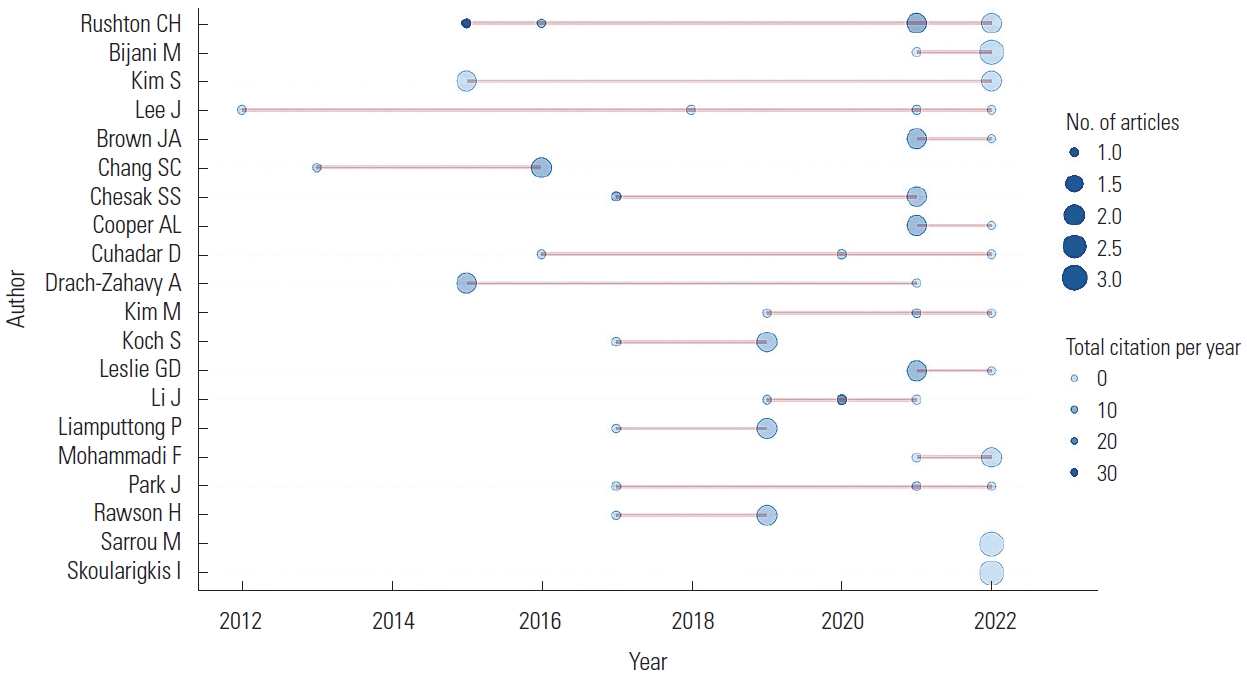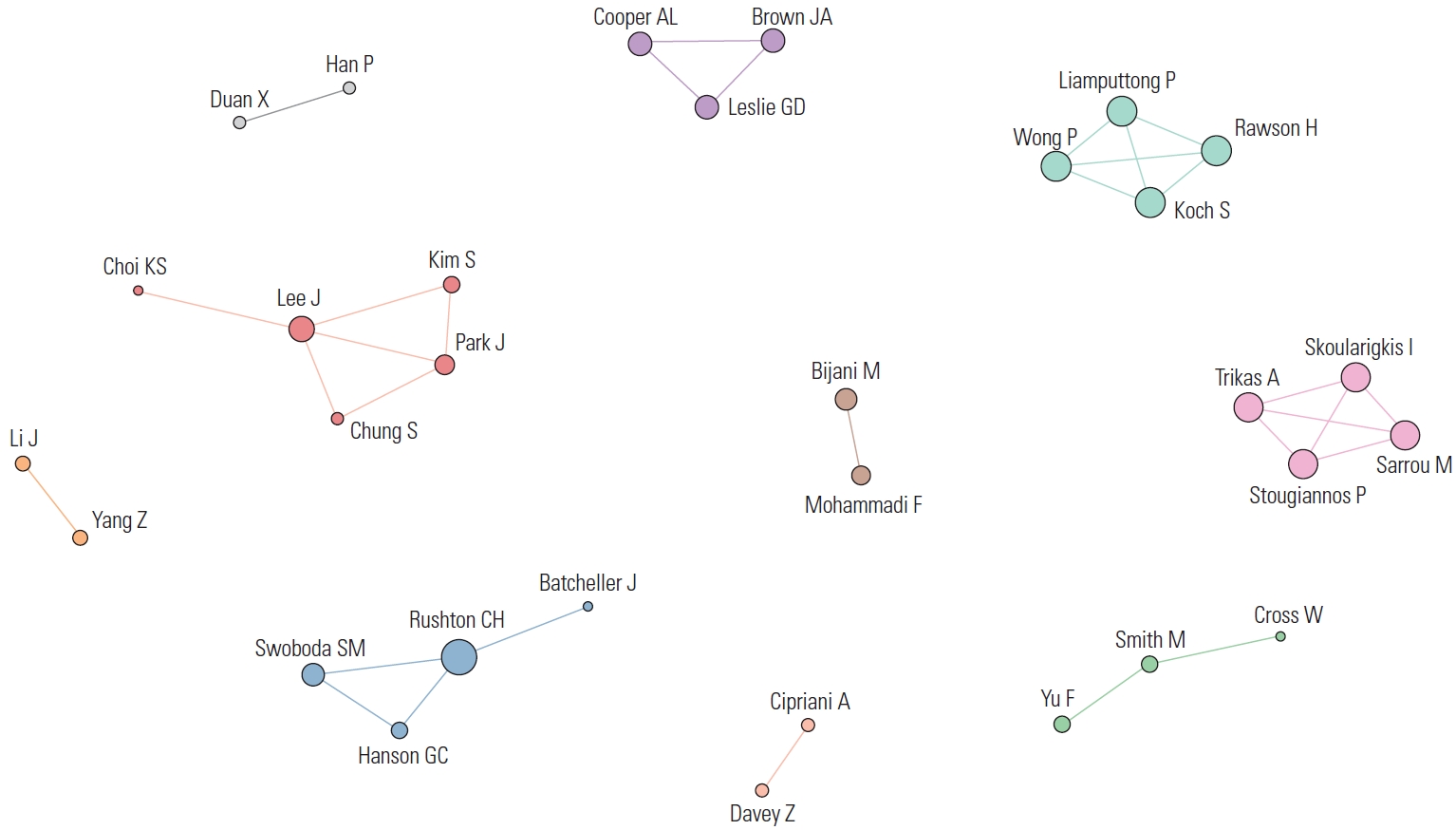Articles
- Page Path
- HOME > Sci Ed > Volume 11(1); 2024 > Article
-
Original Article
Research trends on resilience related to nursing and patients: a bibliometric analysis -
Sukwon Hahn1
 , Young Mi Ryu2
, Young Mi Ryu2
-
Science Editing 2024;11(1):44-54.
DOI: https://doi.org/10.6087/kcse.322
Published online: January 25, 2024
1Department of Nursing, Baekseok Culture University, Cheonan, Korea
2Department of Nursing, Baekseok University, Cheonan, Korea
- Correspondence to Young Mi Ryu youngmiryu@bu.ac.kr
Copyright © 2024 Korean Council of Science Editors
This is an open access article distributed under the terms of the Creative Commons Attribution License (https://creativecommons.org/licenses/by/4.0/), which permits unrestricted use, distribution, and reproduction in any medium, provided the original work is properly cited.
- 1,062 Views
- 64 Download
Abstract
-
Purpose
- Resilience is an essential concept used to describe the ability to cope and adapt effectively in the face of loss, hardship, or adversity by patients, nurses, and nursing students. The purpose of this study was to identify research trends on resilience related to nursing and patients.
-
Methods
- The Web of Science Core Collection database was searched on February 21, 2023, with the terms “resilienc*” in the title and “nurs* and “patient* in the topic. A total of 361 documents were extracted. A web-based analysis in R prepared using web-r.org was used to generate visualizations of publishing trends, journal ranks, authorship analysis, the most prolific nations, author collaboration patterns, a KeyWords Plus analysis, trend themes, and the most cited articles.
-
Results
- Research reports on resilience related to nursing and patients were first published in 2007 and have shown a substantial increase since 2019, with more than 30 publications per year. The largest amount of related literature was published in the Journal of Nursing Management, and the Journal of Advanced Nursing included the largest number of citations. Rushton CH was the most prolific author, with six publications, and she was the author of the most cited study. The most productive country was the United States. The most frequently encountered KeyWords Plus terms were “burnout,” “stress,” and “health.”
-
Conclusion
- The findings of this study can offer information to future researchers as well as the opportunity to conduct more novel studies on resilience in nursing.
- Background and rationale
- In recent decades, as the globalized world has become more vulnerable to fundamental changes and diverse threats, resilience has become a topic of interest in various disciplines [1]. Views of resilience have evolved, and it is now regarded as a novel concept that may be helpful in managing unanticipated personal crises, emergencies, or disasters [1]. Resilience was originally defined as the capacity of a particular material to absorb energy when subjected to elastic deformation and to release it in the absence of a load [2]. This metaphor can be applied to psychological resilience, which is characterized by a similar type of resistance to the psychological pressure associated with negative events [3]. Some individuals appear to have the ability to bounce back more easily and to carry on despite the occurrence of negative events. Psychological resilience is defined as the ability to cope and adapt effectively in the face of loss, hardship, or adversity [3].
- Academic interest in resilience in the field of nursing has shown a significant increase in recent decades. Resilience can now be commonly described as a protective factor for patients [4], family caregivers [5], nurses [6], and nursing students [7]. According to a meta-analysis [8], the use of resilience interventions involving a combination of cognitive behavioral therapy and mindfulness techniques provided a modest beneficial effect. Another meta-analysis [9] reported on the effectiveness of resilience interventions in improving psychological resilience among higher education students with a small effect size. Resilience-enhancing interventions that were administered promptly after diagnosis and in concurrence with somatic treatment had the greatest impact on resilience in adult cancer patients [10]. These studies support the notion that resilience is a contextual and dynamic process rather than a static or inborn quality [11].
- The concept of resilience has received broad acceptance in academic communities and has been applied increasingly to research, instructional, and clinical contexts in the nursing field. However, the topic of resilience in nursing has not been studied comprehensively. A bibliometric analysis of literature on resilience is required to examine the development of research trends on resilience in the nursing field.
- Bibliometric analysis, a popular and rigorous research method, utilizes quantitative tools to analyze massive amounts of scientific data and to assess the impact of research. It can be helpful in the effort to understand intellectual and scholarly trends and shed light on emerging fields [12].
- Objectives
- Using the Web of Science Core Collection database, this study aimed to provide a summary of the trends in reported research in the field through identification of countries, organizations, and authors that have made major contributions to highly cited science publications. The findings of this study could be helpful in the efforts of academics worldwide to better understand the state of research on resilience and to determine its scholarly frontier.
Introduction
- Ethics statement
- This study was conducted as a bibliometric study for the analysis of published articles. The need for ethics committee approval was exempted by the Institutional Review Board of Baekseok Culture University (No. 2-7008132-A-N-01. 22-08).
- Study design
- This is a descriptive study using bibliometric analysis.
- Data source and measurement
- The initial search was conducted on February 21, 2022, using the Web of Science Core Collection database, including all editions such as the Science Citation Index Expanded, Social Science Citation Index, and Conference Proceedings Citation Index-Social Science Humanities. The authors wanted to limit the scope of resilience to nursing and patients; therefore, the search terms were “resilienc*” in the title and “nurs*” and “patient*” in the topic of the documents. The search was set to include articles published between 1900 and 2023. The search retrieved 361 documents. Research on resilience related to nursing and patients was first published in 2007. Therefore, 361 documents published from 2007 to 2023 were analyzed in this study, and the results were interpreted using analytical bibliometric methods.
- Analytical methods
- A summary and visualizations of the results of data analysis were provided. The open source R package Bibliometrix [13] was used to perform bibliometric analyses and construct data matrices for publication trends, journal rankings, authorship analysis, the most productive countries, author collaboration pattern, a KeyWords Plus analysis, trend topics, and the most cited articles.
Methods
- General description of retrieved bibliographic statistics
- Table 1 summarizes the bibliographic statistics. Among 361 studies, the document types included 323 published original articles (90.2%), 21 reviews (8.1%), and nine meeting abstracts (2.5%). The average number of citations per document was 14.50, and the average number of citations per year per document was 2.56.
- Annual scientific production and average article citations per year
- Table 2 shows the annual scientific production of published documents on resilience related to nursing and patients included in the Web of Science Core Collection database from 2007 to 2023. The annual production of scientific research on resilience began in 2007, remained in single digits until 2014, and has since shown a steep increase. More than 30 relevant articles were published in 2019, and the largest number published in a single year occurred in 2022 (n= 78), followed by 2021 with 77 articles. Thus, the annual growth rate was 20.6%, and the results of the Cox-Stuart test for trend analysis showed an increasing trend (P= 0.004).
- The average total citations per year exceeded 150 in 2007, and a downward trend was observed thereafter. This finding reflects the number of citations for a small number of studies published after 2007, and it appears that the average value of citations has decreased since that time, while the number of research reports has increased (Fig. 1 and Table 2).
- Active journals
- The 361 documents included in this study were published in 191 sources. The top 20 journals are shown in Fig. 2. In order, the most relevant journals were the Journal of Nursing Management, Journal of Advanced Nursing, and Journal of Clinical Nursing. The Journal of Advanced Nursing was the first journal to publish research on resilience related to nursing and patients in 2007, and it included the largest number of publications until 2017. A few related studies have been published in the Journal of Nursing Management since 2015, and it now appears to have the most published articles, ahead of the Journal of Advanced Nursing (Fig. 3).
- Authorship analysis
- In total, 1,417 authors contributed to the retrieved documents, specifically 15 authors of single-author studies and 1,402 authors of multi-author studies. The number of documents per author for co-authored publications was 0.26, and the average number of authors per document was 4.34. Among 361 documents, 15 publications (4.2%) were single-authored, and 346 publications (95.8%) were multi-authored. The degree of collaboration among authors was 95.8%.
- The top 20 productive authors are shown in Fig. 4. Among the 1,417 authors, each of the top 20 authors generated three or more documents. Rushton CH of Johns Hopkins University was the most prolific author with six articles (out of 361, 1.7%). She began publishing related studies in 2015, conducted the most studies in 2021, and had the largest number of citations per document (total citations, 381). The next most prolific researchers were Bijani M, Kim S, and Lee J with four articles each. Lee J began conducting research the earliest among these top authors, in 2012, and has continued steadily to 2022. The remaining authors in the top 20 list wrote three articles apiece.
- The United States (103 articles), China (55 articles), Korea (31 articles), Turkey (22 articles), and Australia (21 articles) were the top five countries that produced the most literature on the resilience of nursing and patients (Fig. 5). The United States accounted for 28.5% of total publications (103 of 361). Together, the top five countries accounted for 64.3% of all published documents (232 of 361).
- Author collaboration
- A co-authorship analysis was performed in order to identify connections between authors. A total of 31 authors, organized into 10 groups, were identified within the network of co-authors. These groups of five authors (n= 1), four authors (n= 3), three authors (n = 2), and two authors (n = 4) are shown in Fig. 6. Of the 31 authors, 15 authors were among the top 20 authors. However, their network is poor and is limited to collaboration with two or more subnetworks. In other words, identifying authors with links between research groups with subnetworks was difficult.
- KeyWords Plus analysis
- While keywords are determined by authors and presented in the title, KeyWords Plus terms are derived using a special algorithm from the words that appear frequently in the titles of an article’s references but not in the article’s title. The KeyWords Plus analysis was performed using 617 KeyWords Plus terms. An overlay visualization map of the top 20 most frequent KeyWords Plus terms is shown in Fig. 7A. The most frequently encountered terms were “burnout” (n= 53), “stress” (n= 51), “health” (n = 47), “scale” (n = 46), and “nurses” (n = 44). A KeyWords Plus word cloud for the publications is shown in Fig. 7B. The common terms highlighted in the word cloud are “burnout,” “stress,” and “health.” A multivariate co-occurrence analysis classified the KeyWords Plus co-occurrence network into five specific clusters as shown in Fig. 7C. Regarding KeyWords Plus co-occurrences, the weight of the link between two keywords was determined by the number of co-occurrences of a pair of words. The use of keyword frequencies alone is insufficient to determine the relationships among various terms. Each KeyWords Plus term is represented as a node in a KeyWords Plus co-occurrence network, and each co-occurrence of a pair of words is represented as a link. The weight of the link between these two KeyWords Plus terms is determined by the number of times a pair of terms co-occurs in numerous articles. The network created in this manner is a weighted network. The number of links represents the weights, and the thickness of the links is proportionate to their weight [14].
- The main KeyWords Plus terms for each of the five clusters are as follows. The terms “burnout,” “stress,” and “nurse” appeared with the highest frequency in relation to resilience and were situated close to each other. The cluster where the central term was “health,” which was the largest concept, overlapped with “care” and partially overlapped with “burnout.” In the cluster where “scale” was the central term, “job satisfaction” was the largest subconcept. In the “depression” cluster, “quality of life” was the closest, with the second highest frequency, and “survivors” and “distress” were concepts that belonged to the top 20. In the “mental health” cluster, “impact” was the next most frequent concept, followed by several terms in the order of “satisfaction,” “risk,” “outcomes,” and “anxiety.”
- Trends in topics
- Trends in topics by year are shown in Fig. 8. In 2022, the trend topics included “support,” “personality,” “professionals,” “conservation,” and “resources,” while “scale,” “impact,” “outcomes,” “anxiety,” and “distress” were trend topics in 2021. In 2020, “burnout,” “stress,” “health,” “nurses,” and “care” were reported as trend topics, and the term frequency that year was the highest observed throughout the entire period.
- Most globally cited documents
- The top 10 most globally cited documents are shown in Table 3 [15–24]. The most cited article was titled “Burnout and resilience among nurses practicing in high-intensity settings” and published in 2015 in the American Journal of Critical Care by Rushton et al. [15]. This article was cited 282 times. The most recently published study by Yıldırım et al. [19] in 2022 was titled “Perceived risk and mental health problems among healthcare professionals during COVID-19 pandemic: exploring the mediating effects of resilience and coronavirus fear.” That study was cited 141 times over a period of 2 years and 4 months, from online publication in November 2020 to the search date of this study, making it the most cited study within the shortest period.
Results
- Interpretation
- This study examined the academic progress and emerging trends regarding publication of research on resilience related to nursing and patients. A bibliometric analysis was used to examine fundamental influences, including authors, journals, nations, citation ranks, and KeyWords Plus terms.
- Research conducted on resilience related to nursing and patients has shown a rapid increase since 2019, and the largest number of articles was published in 2022. The most related research was published in the Journal of Nursing Management, and Rushton CH was the most prolific author, with the highest number of citations. The most productive countries were the United States, China, and Korea. The terms most often encountered in the KeyWords Plus analysis were “burnout,” “stress,” and “health.”
- In the KeyWords Plus co-occurrence network analysis, “burnout,” “stress,” and “nurse” had the largest circles located close together. These terms seemed to co-occur most often in studies related to nurses’ resilience; they were also found among the trend topics in 2020. Therefore, interest in nurses’ resilience appears to have increased further with the development of the COVID-19 pandemic. Resilience refers to the ability to respond effectively despite facing adversity [3], so it is natural that research intensified regarding the resilience of nurses who fought against COVID-19 on the pandemic’s front lines. More research should be conducted to improve nurses’ resilience at both the organizational and personal levels to improve the provision of nursing care in difficult situations. The cluster of “health,” “care,” and “work” is closest to nurses’ resilience-related KeyWords Plus cluster. These three terms seemed to co-occur most frequently in resilience studies related to nursing care. Additionally, clusters of “depression,” “quality of life,” “survivors,” and “children” seemed to co-occur most often in research on resilience related to patients. Our study’s result suggests that most of the resilience research related to nursing and patients tended to focus more on nurses than patients, so resilience research related to patients needs to be revitalized in the future.
- Since resilience may be developed at any stage of life, regardless of age or disease, it is necessary to establish educational programs to assist patients in building resilience. The promotion of resilience in patients should be a critical component of care. The development of diverse interventions that enhance resilience for various groups of patients is essential to recover from illness and to improve quality of life.
- Suggestion for further studies
- The number of publications on nursing-related resilience showed a more rapid increase in 2021 and 2022 compared to the natural increase observed before the year 2020. Conducting additional research is recommended to determine whether a concurrent expansion of research on resilience has occurred in other disciplines, such as medicine or pharmacy, not only nursing.
- Limitations
- Despite the usefulness of bibliometric analysis as a scientific tool for evaluating the progress of research in the field, we wish to point out that due to database bias and language bias, the publications included in this study do not represent the entire body of literature on resilience. However, our findings provide comprehensive information on research trends on resilience in relation to nursing and patients.
- Conclusions
- Interest in research on resilience has shown a recent increase. The critical need for the resilience of nurses and patients has increased recently in the nursing field, which supports the importance of this study in examining the general research and publishing patterns of studies related to resilience.
Discussion
-
Conflict of Interest
No potential conflict of interest relevant to this article was reported.
-
Funding
The authors received no financial support for this work.
-
Data Availability
Data analyzed in this article are available from the corresponding author upon reasonable request as Clarivate does not allow researchers to share the data retrieved from the Web of Science.
Notes
Supplementary Materials
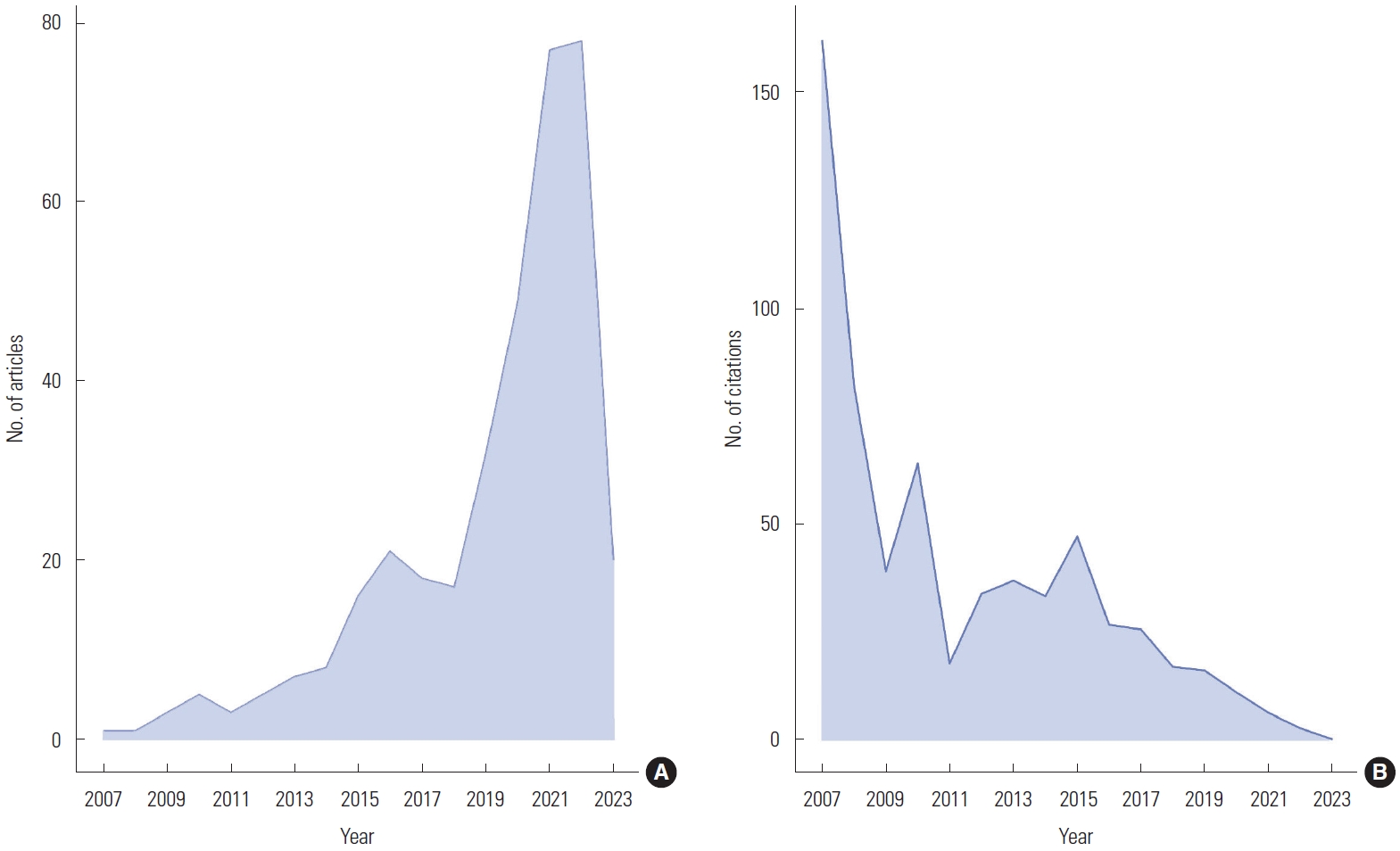
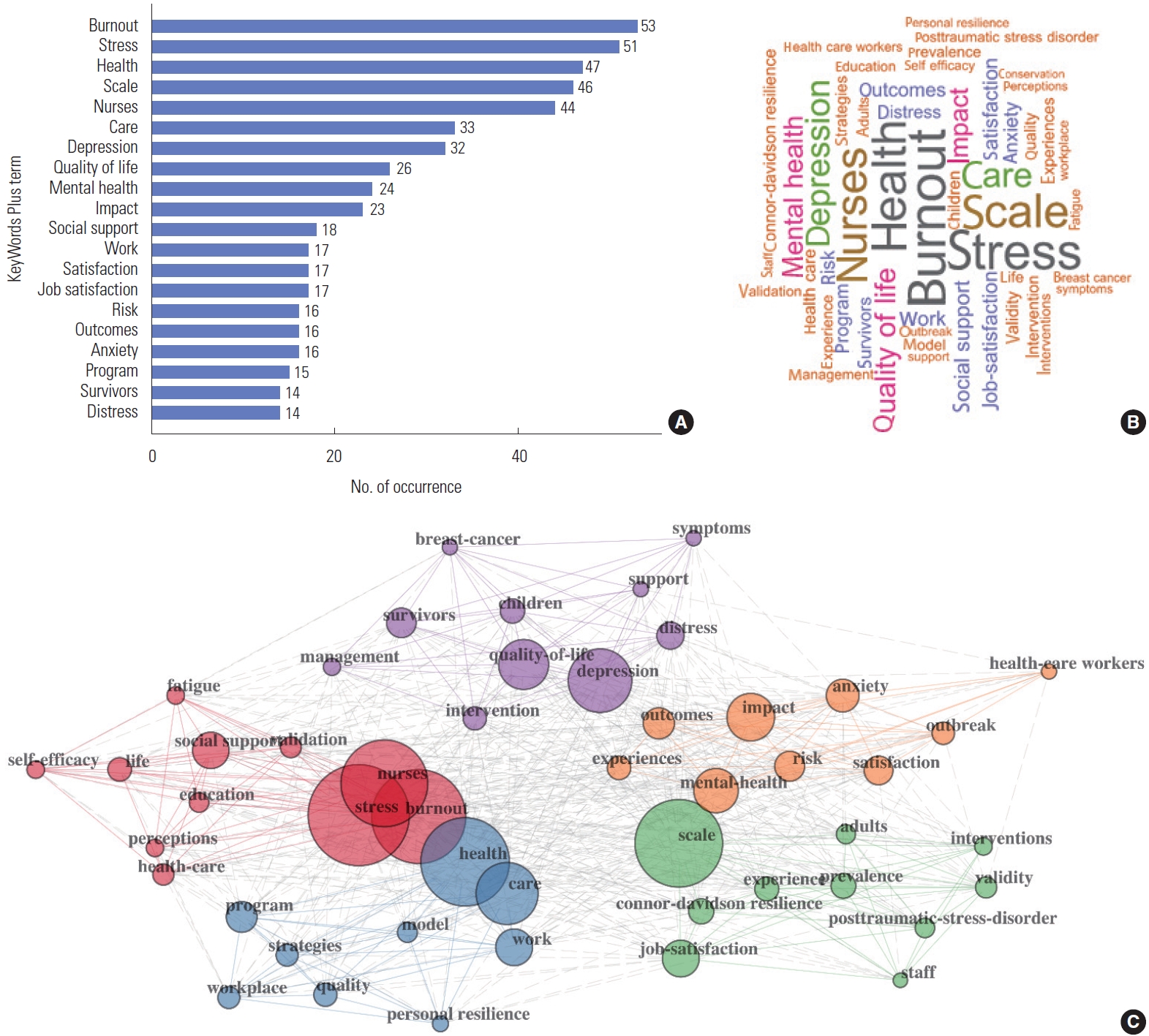
| Rank | Bibliographic information | No. of total citations | Reference |
|---|---|---|---|
| 1 | Rushton CH, Batcheller J, Schroeder K, Donohue P. Burnout and resilience among nurses practicing in high-intensity settings. Am J Crit Care 2015;24:412–20. https://doi.org/10.4037/ajcc2015291 | 282 | [15] |
| 2 | Delgado C, Upton D, Ranse K, Furness T, Foster K. Nurses’ resilience and the emotional labour of nursing work: an integrative review of empirical literature. Int J Nurs Stud 2017;70:71–88. https://doi.org/10.1016/j.ijnurstu.2017.02.008 | 184 | [16] |
| 3 | Ablett JR, Jones RS. Resilience and well-being in palliative care staff: a qualitative study of hospice nurses’ experience of work. Psychooncology 2007;16:733–40. https://doi.org/10.1002/pon.1130 | 162 | [17] |
| 4 | Baek HS, Lee KU, Joo EJ, Lee MY, Choi KS. Reliability and validity of the Korean version of the Connor-Davidson resilience scale. Psychiatry Investig 2010;7:109–15. https://doi.org/10.4306/pi.2010.7.2.109 | 146 | [18] |
| 5 | Yıldırım M, Arslan G, Özaslan A. Perceived risk and mental health problems among healthcare professionals during COVID-19 pandemic: exploring the mediating effects of resilience and coronavirus fear. Int J Ment Health Addict 2022;20:1035–45. https://doi.org/10.1007/s11469-020-00424-8 | 141 | [19] |
| 6 | Yu F, Raphael D, Mackay L, Smith M, King A. Personal and work-related factors associated with nurse resilience: a systematic review. Int J Nurs Stud 2019;93:129–40. https://doi.org/10.1016/j.ijnurstu.2019.02.014 | 117 | [20] |
| 7 | Guo YF, Luo YH, Lam L, Cross W, Plummer V, Zhang JP. Burnout and its association with resilience in nurses: a cross-sectional study. J Clin Nurs 2018;27:441–9. https://doi.org/10.1111/jocn.13952 | 112 | [21] |
| 8 | Kemper KJ, Mo X, Khayat R. Are mindfulness and self-compassion associated with sleep and resilience in health professionals? J Altern Complement Med 2015;21:496–503. https://doi.org/10.1089/acm.2014.0281 | 112 | [22] |
| 9 | Molina Y, Yi JC, Martinez-Gutierrez J, Reding KW, Yi-Frazier JP, Rosenberg AR. Resilience among patients across the cancer continuum: diverse perspectives. Clin J Oncol Nurs 2014;18:93–101. https://doi.org/10.1188/14.CJON.93-101 | 112 | [23] |
| 10 | Itzhaki M, Peles-Bortz A, Kostistky H, Barnoy D, Filshtinsky V, Bluvstein I. Exposure of mental health nurses to violence associated with job stress, life satisfaction, staff resilience, and post-traumatic growth. Int J Ment Health Nurs 2015;24: 403–12. https://doi.org/10.1111/inm.12151 | 96 | [24] |
- 1. Pascariu GC, Banica A, Nijkamp P. A meta-overview and bibliometric analysis of resilience in spatial planning: the relevance of place-based approaches. Appl Spat Anal Policy 2022;16:1097-127.https://doi.org/10.1007/s12061-022-09449-z. ArticlePubMedPMC
- 2. Gere JM, Goodno BJ. Mechanics of materials. 8th ed. Cengage Learning; 2012.
- 3. Tugade MM, Fredrickson BL. Positive emotions and emotional intelligence. In: Barrett LF, Salovey P, editors. The wisdom in feeling: psychological process in emotional intelligence. Guilford; 2002. p. 319–40.
- 4. Choi S, Kim D, Cho A, An S, Kim C, Yoo I. Pathways to post-traumatic growth in Korean female cancer patients: the mediation effects of coping strategies and resilience. Eur J Psychotraumatol 2023;14:2187187. https://doi.org/10.1080/20008066.2023.2187187. ArticlePubMedPMC
- 5. Sánchez-Teruel D, Robles-Bello MA, Sarhani-Robles M, Sarhani-Robles A. Exploring resilience and well-being of family caregivers of people with dementia exposed to mandatory social isolation by COVID-19. Dementia (London) 2022;21:410-2.https://doi.org/10.1177/14713012211042187. ArticlePubMedPMC
- 6. Mousavi SM, Yazdanirad S, Naeini MJ, Khoshakhlagh A, Haghighat M. Determining the effect of selected mental factors on turnover intention through two modulators: stress and resilience over COVID-19 period. BMC Health Serv Res 2023;23:36. https://doi.org/10.1186/s12913-023-09268-z. ArticlePubMedPMC
- 7. Chow KM, Tang WK, Chan WH, Sit WH, Choi KC, Chan S. Resilience and well-being of university nursing students in Hong Kong: a cross-sectional study. BMC Med Educ 2018;18:13. https://doi.org/10.1186/s12909-018-1119-0. ArticlePubMedPMC
- 8. Joyce S, Shand F, Tighe J, Laurent SJ, Bryant RA, Harvey SB. Road to resilience: a systematic review and meta-analysis of resilience training programmes and interventions. BMJ Open 2018;8:e01785. https://doi.org/10.1136/bmjopen-2017-017858. ArticlePubMedPMC
- 9. Ang WH, Lau ST, Cheng LJ, et al. Effectiveness of resilience interventions for higher education students: a meta-analysis and metaregression. J Educ Psychol 2022;114:1670-94.https://doi.org/10.1037/edu0000719. Article
- 10. Ludolph P, Kunzler AM, Stoffers-Winterling J, Helmreich I, Lieb K. Interventions to promote resilience in cancer patients. Dtsch Arztebl Int 2019;51–52:865-72.https://doi.org/3238/arztebl.2019.0865. Article
- 11. Aburn G, Gott M, Hoare K. What is resilience? An integrative review of the empirical literature. J Adv Nurs 2016;72:980-1000.https://doi.org/10.1111/jan.12888. ArticlePubMed
- 12. Donthu N, Kumar S, Mukherjee D, Pandey N, Lim WM. How to conduct a bibliometric analysis: an overview and guidelines. J Bus Res 2021;33:285-96.https://doi.org/10.1016/j.jbusres.2021.04.070. Article
- 13. Aria M, Cuccurullo C. bibliometrix: an R-tool for comprehensive science mapping analysis. J Informetr 2017;11:959-75.https://doi.org/10.1016/j.joi.2017.08.007. Article
- 14. Radhakrishnan S, Erbis S, Isaacs JA, Kamarthi S. Novel keyword co-occurrence network-based methods to foster systematic reviews of scientific literature. PLoS One 2017;12:e0172778. https://doi.org/10.1371/journal.pone.0172778. ArticlePubMedPMC
- 15. Rushton CH, Batcheller J, Schroeder K, Donohue P. Burnout and resilience among nurses practicing in high-intensity settings. Am J Crit Care 2015;24:412-20.https://doi.org/10.4037/ajcc2015291. ArticlePubMed
- 16. Delgado C, Upton D, Ranse K, Furness T, Foster K. Nurses’ resilience and the emotional labour of nursing work: an integrative review of empirical literature. Int J Nurs Stud 2017;70:71-88.https://doi.org/10.1016/j.ijnurstu.2017.02.008. ArticlePubMed
- 17. Ablett JR, Jones RS. Resilience and well-being in palliative care staff: a qualitative study of hospice nurses’ experience of work. Psychooncology 2007;16:733-40.https://doi.org/10.1002/pon.1130. ArticlePubMed
- 18. Baek HS, Lee KU, Joo EJ, Lee MY, Choi KS. Reliability and validity of the Korean version of the Connor-Davidson Resilience Scale. Psychiatry Investig 2010;7:109-15.https://doi.org/10.4306/pi.2010.7.2.109. ArticlePubMedPMC
- 19. Yıldırım M, Arslan G, Özaslan A. Perceived risk and mental health problems among healthcare professionals during COVID-19 pandemic: exploring the mediating effects of resilience and coronavirus fear. Int J Ment Health Addict 2022;20:1035-45.https://doi.org/10.1007/s11469-020-00424-8. ArticlePubMedPMC
- 20. Yu F, Raphael D, Mackay L, Smith M, King A. Personal and work-related factors associated with nurse resilience: a systematic review. Int J Nurs Stud 2019;93:129-40.https://doi.org/10.1016/j.ijnurstu.2019.02.014. ArticlePubMed
- 21. Guo YF, Luo YH, Lam L, Cross W, Plummer V, Zhang JP. Burnout and its association with resilience in nurses: a cross-sectional study. J Clin Nurs 2018;27:441-9.https://doi.org/10.1111/jocn.13952. ArticlePubMed
- 22. Kemper KJ, Mo X, Khayat R. Are mindfulness and self-compassion associated with sleep and resilience in health professionals? J Altern Complement Med 2015;21:496-503.https://doi.org/10.1089/acm.2014.0281. ArticlePubMedPMC
- 23. Molina Y, Yi JC, Martinez-Gutierrez J, Reding KW, YiFrazier JP, Rosenberg AR. Resilience among patients across the cancer continuum: diverse perspectives. Clin J Oncol Nurs 2014;18:93-101.https://doi.org/10.1188/14.CJON.93-101. ArticlePubMedPMC
- 24. Itzhaki M, Peles-Bortz A, Kostistky H, Barnoy D, Filshtinsky V, Bluvstein I. Exposure of mental health nurses to violence associated with job stress, life satisfaction, staff resilience, and post-traumatic growth. Int J Ment Health Nurs 2015;24:403-12.https://doi.org/10.1111/inm.12151. ArticlePubMed
References
Figure & Data
References
Citations


 KCSE
KCSE
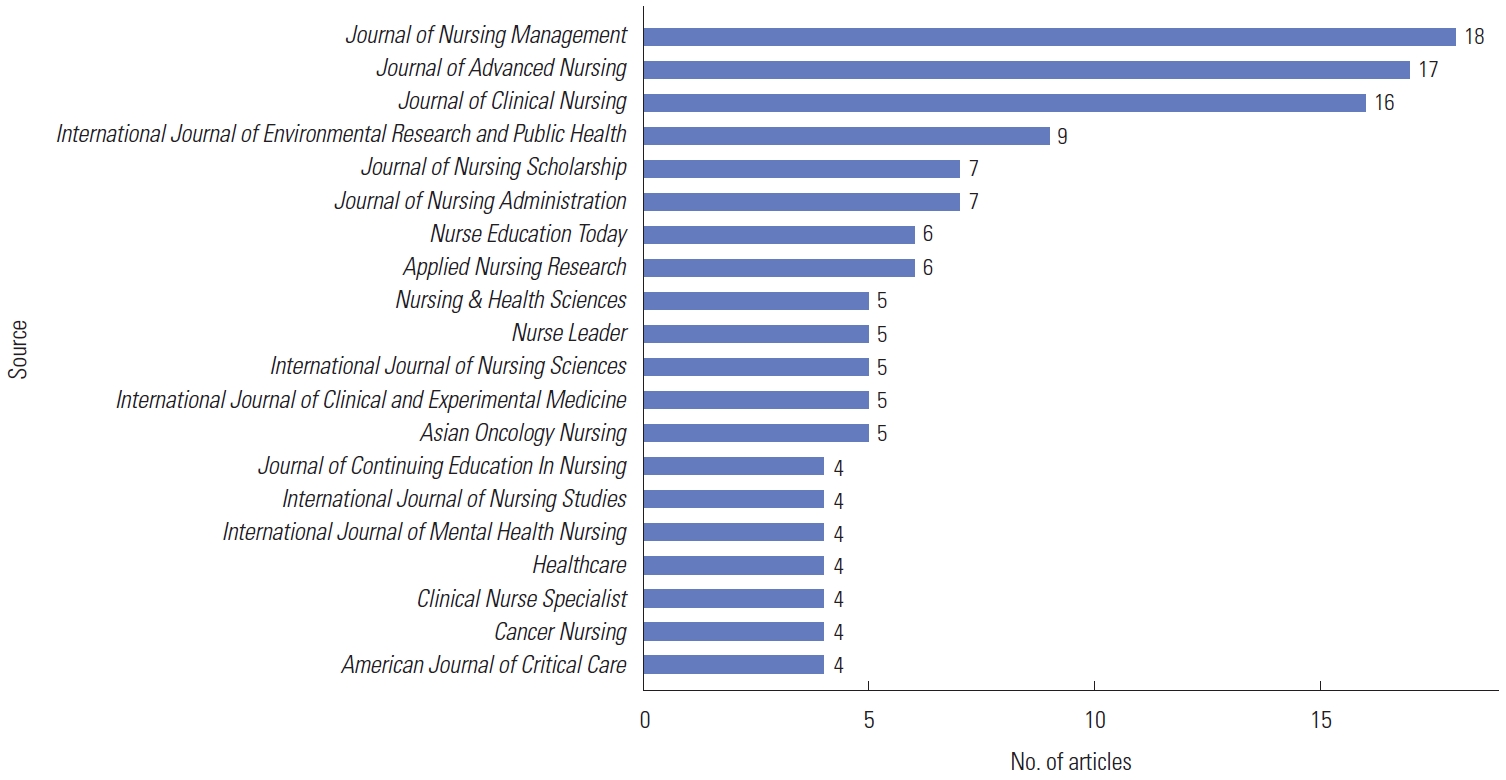
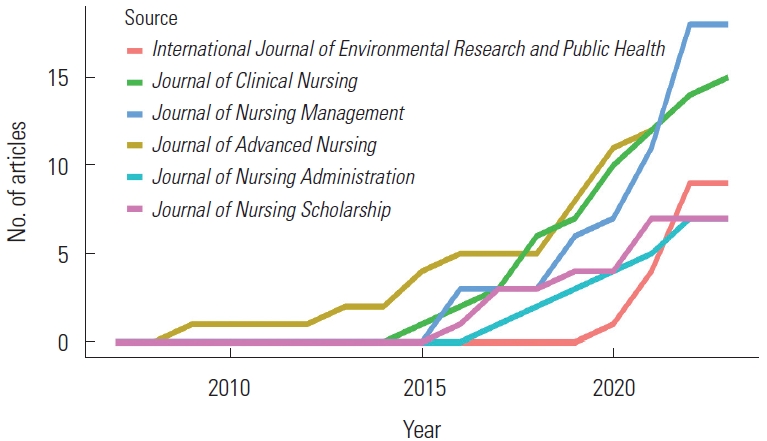

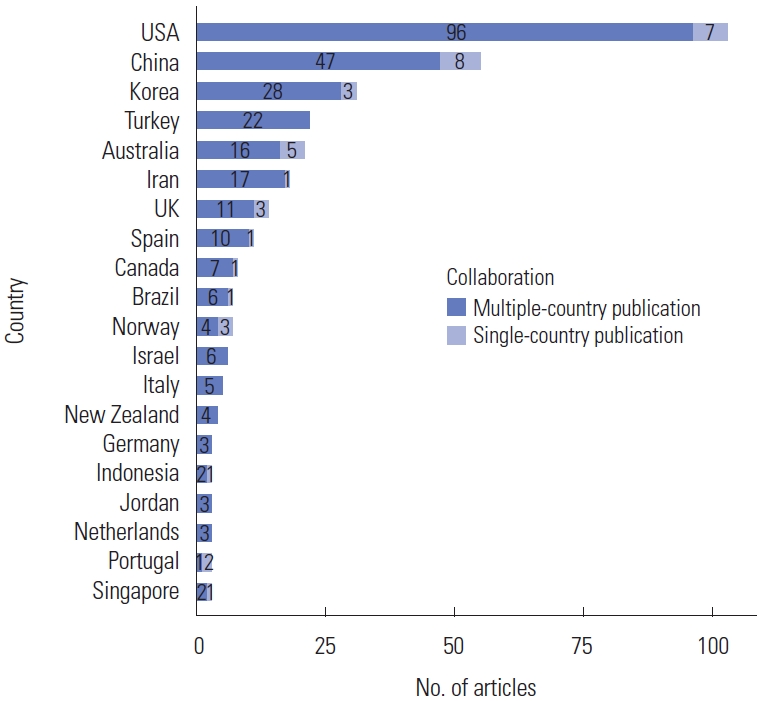

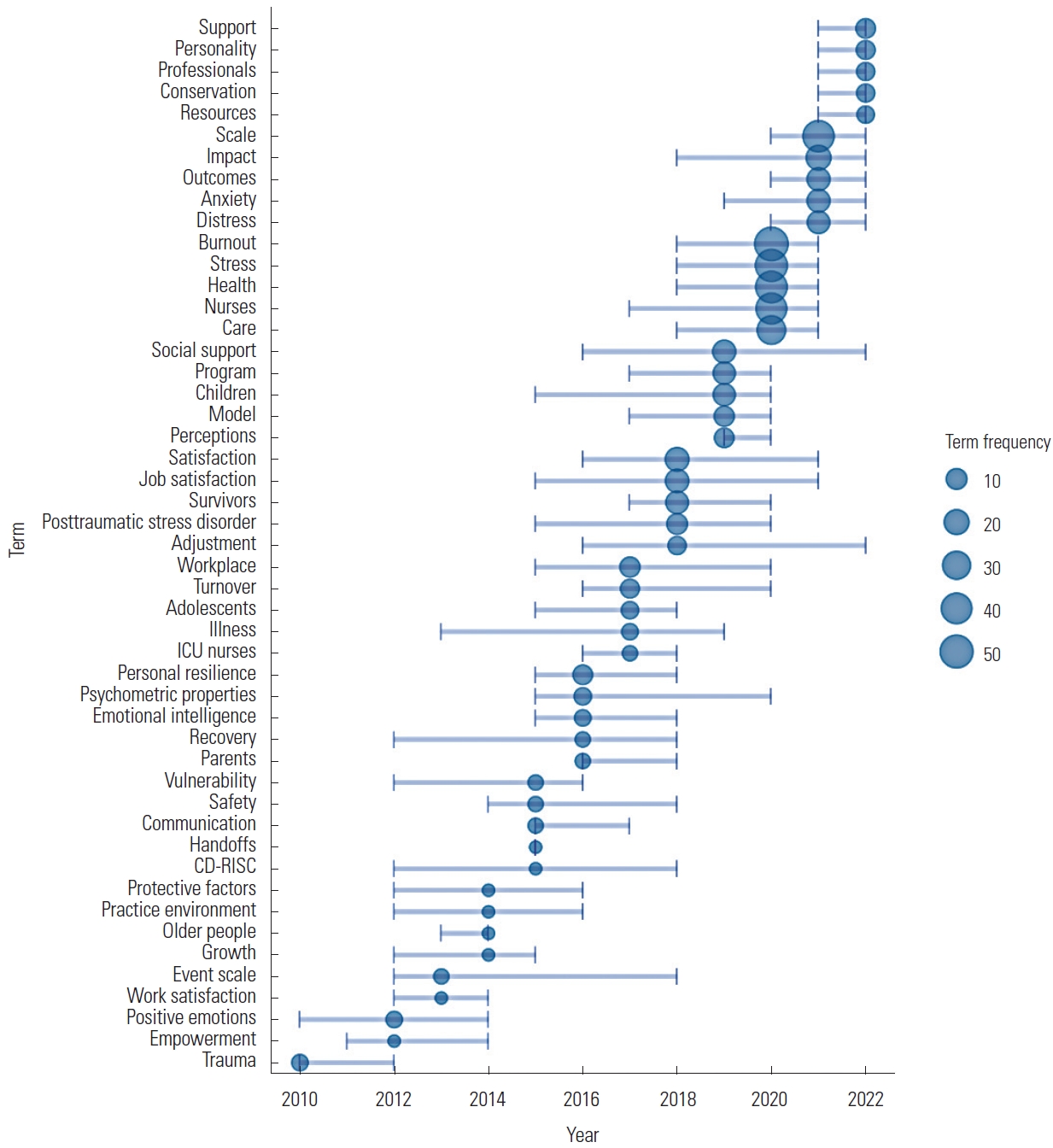
 PubReader
PubReader ePub Link
ePub Link Cite
Cite


